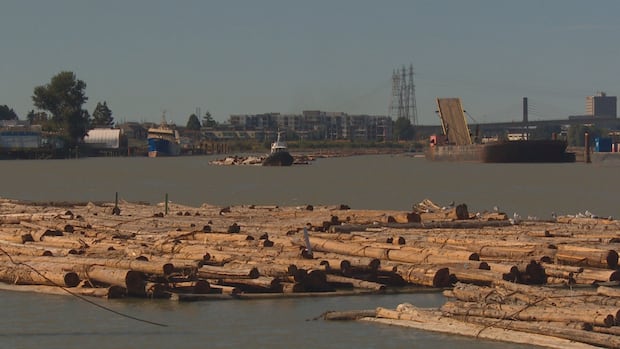Research finds log booms harmful to B.C. salmon and fish habitats
Studies led by First Nations, conservation groups and UBC point to harm caused by storage of logs on rivers

Two new studies are highlighting what researchers say is the harmful effect of log booms — floating structures that contain logs before processing — on fish habitats in B.C. rivers.
A report from the Pacific Salmon Foundation and the B.C. Conservation Foundation (BCCF), led by the Cowichan Tribes, finds the presence of log booms at the mouth of the Cowichan River caused a 20 per cent reduction in survival rates for adult chinook salmon.
Meanwhile, the lead author of a soon-to-be-published study from the University of B.C. and the Musqueam First Nation says that log booms in the Fraser River have a significant effect on nearby habitat, causing more soil to fall onto the riverbed and fewer invertebrates, which could be food for fish, to spawn.
Researchers say the studies show the need for updated log-boom management practices to help fish thrive, something that is particularly urgent as the warming climate causes river levels to drop and makes life more difficult for salmon.
The PSF and BCCF report studied salmon that had been tagged with transponders, with researchers monitoring how human activity affected their survival.
Jamieson Atkinson, lead author of the BCCF study, said the log booms in the Cowichan River led more seals and sea lions to perch there — which, researchers suspect, caused more salmon to be eaten.
The log booms also exacerbate the problem of low river flows, Atkinson said.
"When river discharge is low, it impacts the ability of fish to move into the river and then increases terminal mortality," he said.

"We need to reassess how log booms are stored in estuaries," he added. "And if they run aground, and they're at mouths of rivers, the best option is to remove them into deeper water or out of the water entirely.
"To see it continuing into 2024, it's time that these changes are made," he added.

Log booms also impact fish habitat
Another study, set to be published in the Canadian Journal of Forest Research, looked at the impact of log booms on fish habitat in the Fraser River. It found that the area underneath booms can accumulate wood fibres and bark, and the booms could create oxygen problems for underwater creatures.
UBC forestry professor Scott Hinch, whose graduate student Noah Kussin-Bordo led the study, said the logs could leach chemicals and toxins that could harm the marine environment.
"They can change plant growth," he told CBC News. "Because of the accumulation of material underneath [them], they can also change the sorts of invertebrates that are growing there.
"These, of course, are the food for the fish."
Hinch's study examined 19 sites on the Fraser River, from Pitt Meadows to the river's mouth.
It found that due to how frequently the booms would hit the riverbed because of the shallow depths at which they were floating, the soil under them would "compact" and compress under the repeated impact.

"I believe it was a four to five times higher abundance of invertebrates in our reference sites, compared to the log boom sites," he said, adding that the compacted soil and lack of sunlight meant that far fewer plants were growing on the riverbed — which meant invertebrates did not thrive.
Hinch says both his study and the BCCF study pointed to the fact that water flows are affected by log booms — which could be a future area of research.
Mitigation could be tough: researchers
The researchers say climate change and the changing river patterns that have come with drought conditions could prove challenging when it comes to mitigating the impact of log booms.
Hinch says that best management practices state booms should not be tethered in river areas shallower than 12 metres, but few areas in the Lower Fraser River meet that criteria.
"You almost have to push them further out away from the shore," he said. "But unfortunately, when you do that, you start getting into ship traffic and other navigational issues."

Hinch says one option could be "fallowing" the sites where log booms are stored after they're removed, in other words, not returning them to the same location, to allow for the area's natural recovery.
Atkinson's study also suggests log mills could move their operations to locations that are less critical for salmon populations.
Both Hinch and Atkinson agree that First Nations should take the lead in negotiating with forestry companies and the provincial government on the issue of log booms.
B.C.'s Ministry of Forests said it had received the BCCF report and is reviewing its findings.
Corrections
- An earlier version of this story stated that Scott Hinch was the lead author of the UBC study into log booms. In fact, it was his graduate student Noah Kussin-Bordo.Jun 24, 2024 6:47 PM EDT
With files from Claire Palmer


